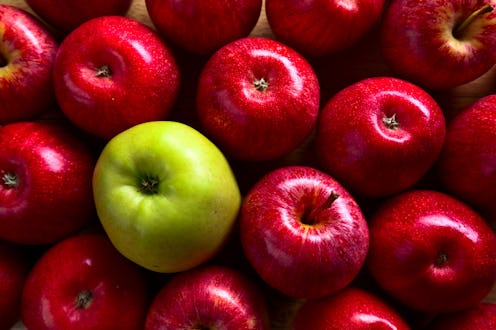Life
Your Fall Apple Options May Look A Little Different This Year

In shocking news to absolutely no one with taste buds, Red Delicious is no longer America’s favorite apple. After dominating grocery stores for more than five decades, Red Delicious is forecasted to cede its first place standing as America’s most produced variety of apple to the Gala apple, the U.S. Apple Association reported last week. The Gala apple’s rise to stardom can be attributed to its sweeter taste and crisper texture, noted the Apple Association. Farmers appreciate the variety, which originated in New Zealand in the 1930s, for its relatively easy growing abilities and productivity.
Red Delicious dropped to second place, with its production projected to fall from around 58 million units in 2017 to 51.7 million units in 2018. Production of Gala apples was estimated to jump up roughly 5.8 percent to 52.4 million units in 2018, just barely edging out its Red Delicious competition. The ever reliable Granny Smith came in third place, followed by Fuji apples, and Honeycrisp, respectively.
The deceptively-named Red Delicious apple, with its aesthetically perfect exterior and extremely bland interior, tastes like childhood lunchbox anguish. I never forgot the crestfallen faces of fellow classmates after opening a parent-packed lunch that featured a Red Delicious apple for “dessert.” Anyone who’s ever had the misfortune of taking a bite out of one of these apples knows it mostly tastes like regret that you didn’t have the foresight to buy a different kind of apple (I am partial to Fuji apples myself).
In an interview with The New York Times, the U.S. Apple Association director of industry affairs Mark Seetin credited the production decline of Red Delicious apples to the orchard industry “adapting to the consumer’s demands.”
And it makes sense—with all of the apple options available in the grocery store produce aisle, why wouldn’t consumer preferences lean towards crisper and sweeter varieties? As Slate reported, much of the Red Delicious’s popularity is owed to “a general trend in mid- to late-20th-century American agriculture that privileged sturdy and beautiful varieties over the fragile, ugly, and tasty.”
“We started eating with our eyes and not our mouths,” Tom Burford, an apple historian and orchard consultant, told The New York Times.
Luckily, the rise of healthy eating and wellness trends over the past few years have made consumers wise up to the fact that you don’t have to sacrifice taste in pursuit of health, helping people pay more attention to the quality of what they put in their bodies.
Young upstart Honeycrisp, for example, has jumped in popularity despite its relatively recent development by the University of Minnesota. Honeycrisp apples, characterized by their crunchy texture and sweetness, were only introduced in 1991. If the current growth rates continue, the U.S. Apple Association anticipates that Honeycrisp apples may oust Granny Smith and Fuji apples for third place by 2020.
However, Red Delicious apples’ reign isn’t necessarily over. Red Delicious still makes up approximately half of the U.S. apple export market, notes the Apple Association. Domestically, at least, we can rest assured that we live in a new era of apple-eating, one where taste outshines looks.